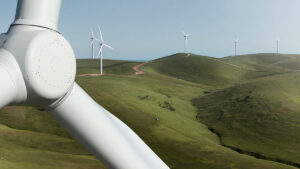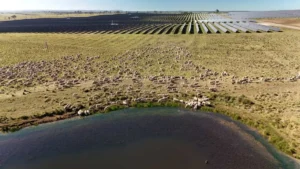The global resources company behind a ground-breaking project that shifted a West Australian gold mine to a more than 50% mix of wind, solar and battery storage says it could aim much higher in future projects – and has set its sights on a target of 99% renewables.
South Africa-based miner Gold Fields has gained a name in Australia for making its Agnew mine, in Leinster Western Australia, the first major gold mine globally to combine solar, wind, and battery storage, with back-up from the gas generators.
The ground-breaking project, completed in May of this year in partnership with EDL, and with the backing of the Australian Renewable Energy Agency, installed 18MW of wind power, 4MW of solar PV, a 13MW/4MWh Saft battery energy storage system and an off-grid 21MW gas/diesel engine power plant.
In a presentation to the Energy & Mines 2020 virtual summit on Tuesday, Gold Fields Australia’s unit manager of electrical operations, James Koerting, said the hybrid power system had overcome stability risks and was running reliably at an annual average of around 54% renewables, and on occasion as high as 78%.
The main reason that it wasn’t operating at a higher renewable capacity was the current design of the system, which relies on a minimum of two engines online at half load and the synthetic inertia provided by the battery to meet the system’s stability requirements.
“To further increase Agnew’s renewable fraction towards 100% we would need to increase the installed base of both renewables and storage,” Koerting told the summit.
“But I think aiming for 100% will come at too high a cost, with diminishing returns, so for future projects we’ll set our sights on a more realistic 99%,” he said.
How would this be achieved? Koerting says the key ingredients for emissions reduction for mining microgrids is renewables, plus inertia, plus storage, plus thermal back-up.
One of the biggest hurdles, he says, is eliminating the thermal back-up, particularly considering the cost of ownership of this low-use asset is much lower than a day of lost production for most mining operations.
But the learnings from the Agnew project have already revealed plenty of room for improvement. Mostly in the energy storage and smart control department of the microgrid.
“As big as [the Agnew] battery is, it only provides the microgrid with supply security as a buffer for gas generators starts. It does not give us the ability to store renewable energy for arbitrage,” Koerting noted.
This leads to a notable inefficiency for the microgrid, where it regularly curtails zero marginal cost energy and LGCs “in favour of shipping and burning hydrocarbons” by running the thermal plant, he said.
 According to Koerting, this 2MW of thermal power will cause renewables to be further curtailed, leading to a total level of solar and wind curtailment that almost disqualified the project from the ARENA funding – until the team was able to convince ARENA that curtailment was the lowest-cost method of pushing up renewable fraction while energy storage costs remained high.
According to Koerting, this 2MW of thermal power will cause renewables to be further curtailed, leading to a total level of solar and wind curtailment that almost disqualified the project from the ARENA funding – until the team was able to convince ARENA that curtailment was the lowest-cost method of pushing up renewable fraction while energy storage costs remained high.
“It is here where my lessons learned start to [inform] what I think the future of renewable energy projects will look like,” Koerting told the webinar.
“Agnew has a technical constraint that requires us to run at least two gas generators at all times to ensure the minimum system inertia requirements are met.
“But what if we could lift that constraint with another form of inertia and utilise the curtailed energy to drive up the renewable fraction?
“Examples of how we could do this include utilising the batteries to produce synthetic inertia or to integrate synchronous condenser or a flywheel,” he said.
“Storage …is the next technology frontier for decarbonisation, and with a project like Agnew we already have a platform with curtailed energy ready and waiting to be stored at no additional cost,” Koerting told the summit.
“We are agnostic as to whether it is a battery or another chemical or thermal process, potential energy system such as pumped hydro or hydrogen, as long as it can match the marginal cost of our thermal generation.”










